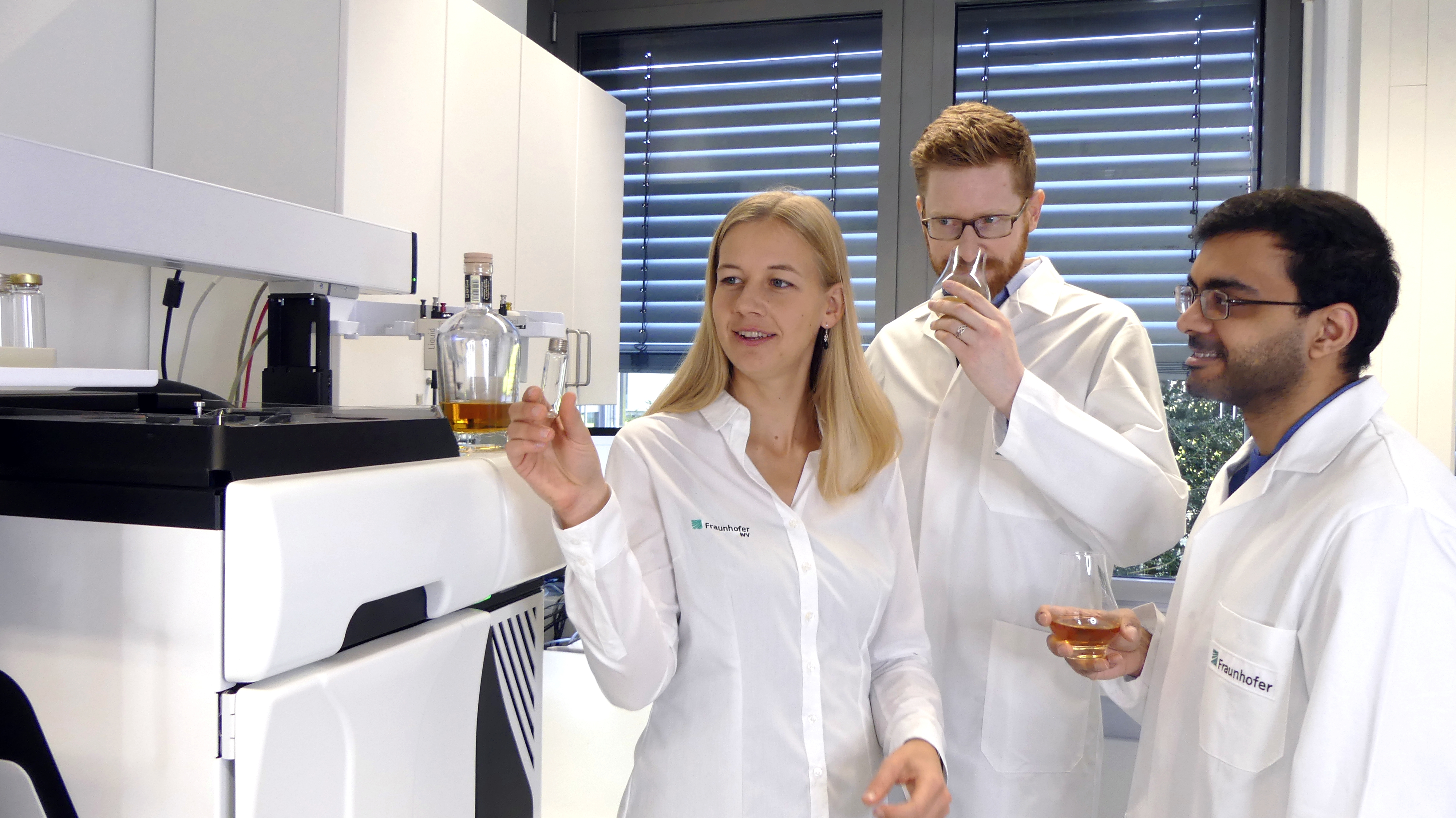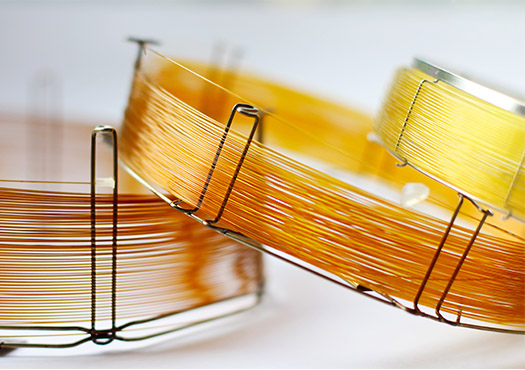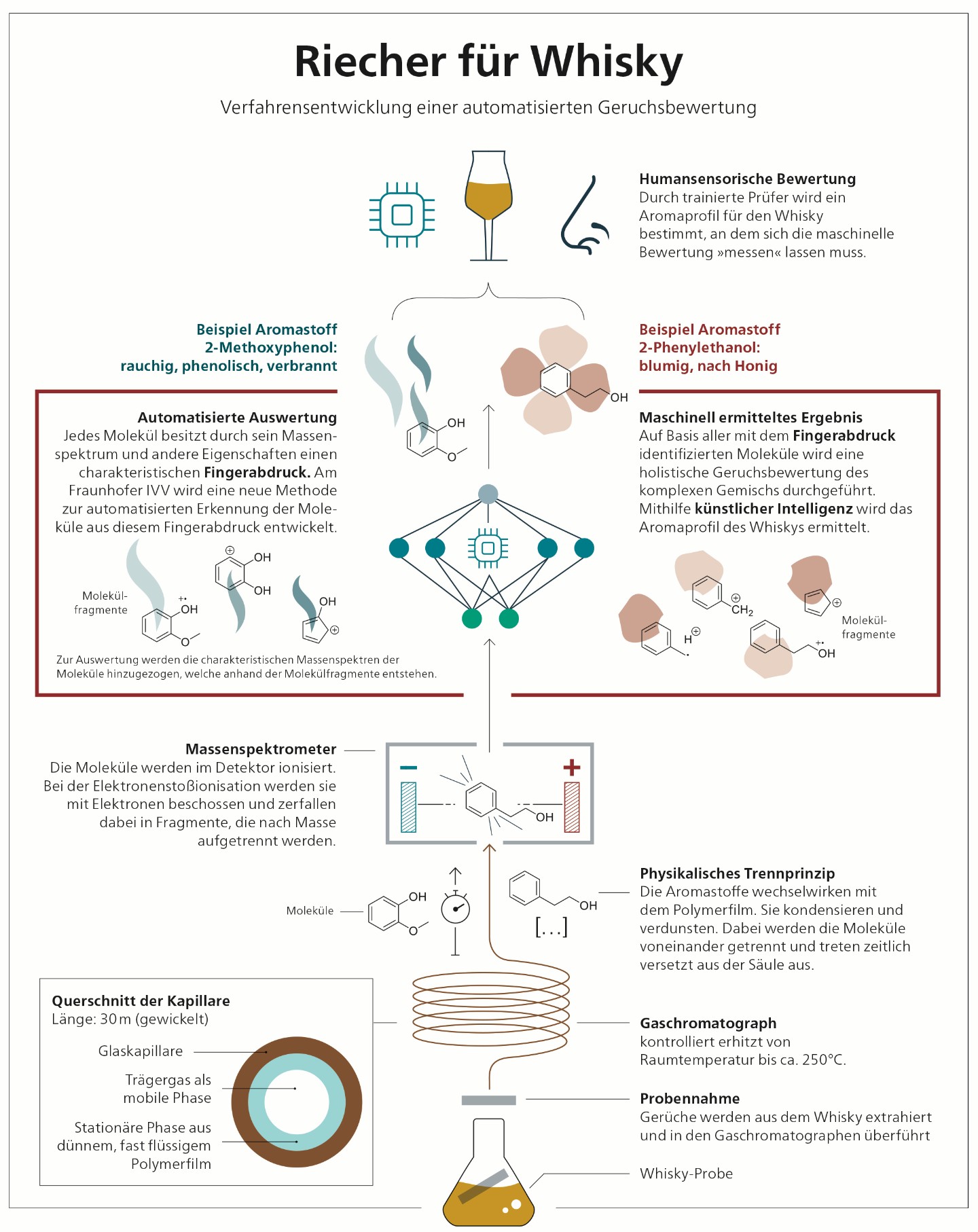Optimized whiskey blending: A project aiming at digitalizing taste and odor metrics to predict whiskey flavors.
Flavors determine how we perceive odor and taste and are a decisive factor in ensuring the popularity and success of a food product on the market. At Fraunhofer IVV, we are working intensively in the area of product performance to decode and identify the substances that cause certain flavors and to optimize the chemical and sensory properties of a wide range of products. The established flavor analysis methods used for this can be very complex, time-consuming and cost-intensive.
Due to its highly complex flavor profiles, whiskey is a perfect test subject for this research field. That is why our scientists hope to use it to develop a customizable tool that can efficiently identify and analyze the flavor molecules in a mixture and then predict the flavor profile of a product based on this information.
Digital flavor profile prediction — the key to optimizing whiskey blending and more
When drinking whiskey, consumers detect a variety of flavors that are characteristic of particular types of whiskey and their production processes. This means that the range of flavors in a whiskey can vary depending on how it is produced, what its ingredients are and where it originated, as each of these factors give rise to different flavor properties. A whiskey can have fruity, flowery or smoky notes or a vanilla or honey flavor. This flavor is a result of the various steps of the whiskey production process. These steps, such as barrel aging and blending, can be the crucial factor for achieving the desired type of whiskey. When it comes to blending, years of expertise are required in order to create new whiskeys or simply ensure consistent quality.
This is exactly where Fraunhofer IVV’s whiskey project comes in: it aims to support the creative process of blending using digital methods. The IVV researchers have found a way of automatically measuring the flavor of whiskey, and thus the chemical and sensory perception processes that a consumer experiences when drinking it, and have transferred this information into digital, automated processes.
The project focuses on the chemical composition of flavor profiles in a variety of whiskeys. Automated analysis and artificial intelligence will be used to predict the whiskeys’ flavor properties. This process will be supplemented and validated by human sensory testing. Then, the research findings will be converted into a digital system that will enable a precise prediction of what the mixtures consist of. The project will ultimately provide blending experts — known as master blenders — with an automated tool that can optimize the process of whiskey blending through targeted flavor prediction, ensuring that their variety of whiskey acquires the desired flavoring and a consistent taste.
Methods for predicting and analyzing whiskey flavors
Combining flavor analysis, automated data processing and human sensory testing has enabled our scientists to extensively investigate, analyze and characterize whiskey flavors, and produce predictions on the basis of this information. However, none of this would be possible without analytical measurement data. The first step in the process is to extract the flavoring components from the whiskey samples using a customized method and analyze them through gas chromatography–mass spectrometry. The resulting data is then processed using an automated analysis tool designed and developed specifically for this application field. In our next step, we combine the corresponding human sensory data with the processed analytical data. The human sensory data, which is used for odor analysis of the whiskey, is obtained using rapid sensory profiling. In this way, data from previous processes can be used as a basis for training artificial intelligence, so that it can produce high-precision predictions of flavor profiles. This principle can also be transferred to other fields of application and used to detect for purposes such as detecting off-flavors at an early stage.
Interdisciplinary collaboration: a must for digitalizing flavor analysis
The success of this project can be attributed to the expertise and collaboration of our interdisciplinary team comprising engineers, psychologists, food chemists and neuroscientists. Thanks to this crew of scientists from diverse disciplines and the expertise we have accrued over many years of experience in the fields of conventional flavor analysis, multisensory technology and data science, we were able to collect precise data on whiskey consumers’ chemical and sensory perception processes and successfully transfer this into digital systems.
An automated standard for efficient flavor analysis in product optimization processes
The insights we have gained from this digital solution for analyzing whiskey flavors represent a valuable discovery for other areas of flavor analytics as well. The principle applied here can be adapted to the requirements of any use case and adjusted to reflect the needs of our customers. As such, our flavor molecule analysis services go beyond conventional flavor analysis, and enable us to develop application-specific solutions even for small and medium-sized companies. Be it for quality assurance, detecting off-odors at an early stage or developing new food products — our extensive portfolio allows us to support companies in monitoring and optimizing the human sensory properties of their products through process-related flavor profile analyses, thus saving time and reducing costs. We aim to build up a pool of data and develop a customized methodology, so that in the future, we will be able to feed a wide variety of data types into the system where it can be read and analyzed.
This research project is part of the Campus of the Senses initiative and is funded by the Bavarian state ministry for economic affairs, regional development and energy (Bayerisches Staatsministerium für Wirtschaft, Landesentwicklung und Energie). Campus of the Senses is a joint project run by the Fraunhofer Institute for Process Engineering and Packaging IVV and the Fraunhofer Institute for Integrated Circuits IIS. |
|
Scientific articles, contributions and awards: |
|
 Fraunhofer Institute for Process Engineering and Packaging IVV
Fraunhofer Institute for Process Engineering and Packaging IVV

